ニコチンアミド
| 分子式: | C6H6N2O |
| その他の名称: | ジペギル、ベコニット、ペロニンアミド、ニオジミン、ニコサン2、ニコホルト、アミニコチン、ニカミンドン、ニコチラミド、ビタミンB3、ニアシンアミド、ニコチンアミド、ナイアシンアミド、ニコチン酸アミド、Dipegyl、Nicofort、Niozymin、Aminicotin、Nicamindon、Nicosan 2、Benicot、Vitamin B3、Niacinamide、Nicotilamide、Nicotinamide、Pelonin amide、3-Pyridinecarboxamide、ニアシナミド、ベニコート、3-Carbamoylpyridine、Pyridine-3-carboxamide |
| 体系名: | ピリジン-3-カルボアミド、3-ピリジンカルボキサミド、3-ピリジンカルボアミド、3-カルバモイルピリジン |
ニコチンアミド
| 化合物名や化合物に関係する事項: | ドライアイス ナフタレン酢酸 ニコチン ニコチンアミド ニコチンアミドアデニンジヌクレオチド ニコチンアミドアデニンジヌクレオチドリン酸 ニコチン酸 |
ニコチン酸アミド、ニコチンアミド
ニコチンアミド
出典: フリー百科事典『ウィキペディア(Wikipedia)』 (2024/11/10 07:53 UTC 版)
| ニコチンアミド | |
|---|---|
 |
|
|
pyridine-3-carboxamide |
|
|
別称
3-pyridinecarboxamide
niacinamide nicotinamide nicotinic acid amide Vitamin PP |
|
| 識別情報 | |
| CAS登録番号 | 98-92-0  |
| PubChem | 936 |
| ChemSpider | 911  |
| UNII | 25X51I8RD4  |
| EC番号 | 202-713-4 |
| KEGG | D00036  |
| ChEMBL | CHEMBL1140  |
|
|
|
|
| 特性 | |
| 化学式 | C6H6N2O |
| モル質量 | 122.12 g mol−1 |
| 融点 | 128-131 °C |
| 特記なき場合、データは常温 (25 °C)・常圧 (100 kPa) におけるものである。 | |
ニコチンアミド(nicotinamide: Nam)は、ニコチン酸(ナイアシン/ビタミンB3)のアミドである。ニコチンアミドは水溶性ビタミンで、ビタミンB群の一つである。ナイアシンアミド(niacinamide)、ニコチン酸アミド(nicotinic acid amide)とも呼ばれる。欠乏症でペラグラとなる[1]。
外用薬の成分としてニキビ(尋常性痤瘡)の治療や、美容目的で化粧品に配合される[2]。日本では医薬部外品の化粧品として、美白の有効成分(ニコチン酸アミド)[3]や、シワ改善の有効成分(リンクルナイアシン)[4]としても承認されている。
血管拡張作用も有しており、即効性を速めるためにインスリン アスパルトに添加された製剤が承認されている[5]。
生理
ナイアシンとしても知られるニコチン酸は in vivo でニコチンアミドから変換されるが、ビタミンとしての機能はそれぞれ全く同じである。しかしニコチンアミドには、偶発的ナイアシン変化による薬理学的毒性効果はない。したがってニコチンアミドはコレステロールを還元せず、皮膚の紅潮も引き起こさない[6]。
細胞では、ナイアシンはNADとNADPから組み込まれるが、ニコチンアミドとニコチン酸のその経路は非常に似ている。NAD+とNADP+は、酵素的酸化還元反応において広く用いられる補酵素である[7]。
欠乏症と過剰症
外用薬として
ニキビ治療薬
ニキビ(尋常性痤瘡)に対して、2017年のレビューで以下が発見された[2]。80人の被験者で、抗生物質のエリスロマイシンと同等の病変の減少が見られニコチンアミドでは皮脂が減少していた[9]。76名の被験者で、中等症のニキビに対して、ニコチンアミドはクリンダマイシンと同等の有効性であった[10]。白人と日本人計50人が被験者となったRCTでは、皮脂の分泌に関して日本人では排泄速度を、白人では分泌量を抑制した[11]。中等症のニキビに対して、クリンダマイシンにニコチンアミドを追加してもクリンダマイシン単独との差はなかった[12]。
また、同年の別のレビューでは以下が発見された[13]。ニコチンアミドは脂性肌、クリンダマイシンはそうでない場合により有効であった[14]。またニコチン酸アミドとリン脂質を使った研究があった[15]。
美容・化粧品
美容に対しては、2017年のレビューで以下が発見された[2]。30人の健康な女性が被験者となったランダム化比較試験 (RCT) では、シワを減少した[16]。50名でのRCTではシワ、色素沈着、黄色味が減少し、弾力が向上した[17]。色素沈着を減少[18]。
また、翌2018年のレビューで以下が発見された[19]。RCTで、わきの下の色素沈着について、良好な結果があった比率はニコチンアミドで24%、デソニド(ステロイド外用薬)で30%、偽薬で6%であった[20]。RCTで、トラネキサム酸とニコチンアミドを配合したクリームを用いて、42名の韓国人女性の顔にある不規則な色素沈着を減少させた[21]。
日本では上述のとおり、医薬部外品の化粧品の有効成分として、2007年から美白有効成分(ニコチン酸アミド)として承認されている[3]。色素のメラニンを生成する酵素のチロシナーゼを阻害するのではなく、メラノソーム転移を35% - 68%阻害して色素沈着を減少させる[18]。また、2018年からはナイアシンアミドのシワ改善作用の効能表示が承認されている[4]。
脚注
- ^ a b 一ノ宮愛、西本勝太郎「ペラグラの1例」『日本臨床皮膚科医会雑誌』第33巻第4号、日本臨床皮膚科医会、2016年、477-482頁、doi:10.3812/jocd.33.477。
- ^ a b c E. Forbat, F. Al-Niaimi, F. R. Ali (2017-3). “Use of nicotinamide in dermatology”. Clinical and experimental dermatology 42 (2): 137–144. doi:10.1111/ced.13021. PMID 28052374.
- ^ a b 長沼雅子「香粧品の有効性の歴史的変遷」『日本香粧品学会誌』第39巻第4号、2015年、275-285頁、doi:10.11469/koshohin.39.275。
- ^ a b 松井基一 (2018年6月20日). “シワ改善でアンチエイジング 化粧品続々”. 日本経済新聞. 2019年6月18日閲覧。
- ^ “新規の超速効型インスリン「フィアスプ注」発売 ノボラピッド注より吸収速度が速く血糖降下作用も速い ノボ”. 糖尿病リソースガイド. 2024年11月10日閲覧。
- ^ Jacenollo, P. (1992). Niacin versus niacinamide
- ^ Belenky P; Bogan KL, Brenner C (2007). “NAD+ metabolism in health and disease”. Trends Biochem. Sci. 32 (1): 12–9. doi:10.1016/j.tibs.2006.11.006. PMID 17161604 2007年12月23日閲覧。.
- ^ Knip M, Douek IF, Moore WP, et al. (2000). “Safety of high-dose nicotinamide: a review”. Diabetologia 43 (11): 1337–45. doi:10.1007/s001250051536. PMID 11126400.
- ^ Y. Weltert, S. Chartier, C. Gibaud, S. Courau (2004-9). “Double-blind clinical assessment of the efficacy of a 4% nicotinamide gel (Exfoliac NC Gel) versus a 4% erythromycin gel in the treatment of moderate acne with a predominant inflammatory component”. Nouvelles Dermatologiques 23 (7): 385-394.
- ^ A. R. Shalita, J. G. Smith, L. C. Parish, M. S et al. (1995-6). “Topical nicotinamide compared with clindamycin gel in the treatment of inflammatory acne vulgaris”. International journal of dermatology 34 (6): 434–437. PMID 7657446.
- ^ Zoe Diana Draelos, Akira Matsubara, Kenneth Smiles (2006-6). “The effect of 2% niacinamide on facial sebum production”. Journal of cosmetic and laser therapy 8 (2): 96–101. doi:10.1080/14764170600717704. PMID 16766489.
- ^ S. K. Dos, J. N. Barbhuiya, S. Jana, S. K. Dey (2003). “Comparative evaluation of clindamycin phosphate 1% and clindamycin phosphate 1% with nicotinamide gel 4% in the treatment of acne vulgaris”. Indian journal of dermatology, venereology and leprology 69 (1): 8–9. PMID 17642812.
- ^ Frances M. Walocko, Ariel E. Eber, Jonette E. Keri et al. (2017-9). “The role of nicotinamide in acne treatment”. Dermatologic therapy 30 (5). doi:10.1111/dth.12481. PMID 28220628.
- ^ Effat Khodaeiani, Rohollah Fadaei Fouladi, Mehdi Amirnia et al. (2013-8). “Topical 4% nicotinamide vs. 1% clindamycin in moderate inflammatory acne vulgaris”. International journal of dermatology 52 (8): 999–1004. doi:10.1111/ijd.12002. PMID 23786503.
- ^ P. Morganti, E. Berardesca, B. Guarneri, F et al. (2011-10). “Topical clindamycin 1% vs. linoleic acid-rich phosphatidylcholine and nicotinamide 4% in the treatment of acne: a multicentre-randomized trial”. International journal of cosmetic science 33 (5): 467–476. doi:10.1111/j.1468-2494.2011.00658.x. PMID 21668835.
- ^ Akira Kawada, Natsuko Konishi, Naoki Oiso et al. (2008-10). “Evaluation of anti-wrinkle effects of a novel cosmetic containing niacinamide”. The Journal of dermatology 35 (10): 637–642. doi:10.1111/j.1346-8138.2008.00537.x. PMID 19017042.
- ^ Donald L. Bissett, John E. Oblong, Cynthia A. Berge (2005-7). “Niacinamide: A B vitamin that improves aging facial skin appearance”. Dermatologic surgery : official publication for American Society for Dermatologic Surgery [et al.] 31 (7 Pt 2): 860–865. PMID 16029679.
- ^ a b T. Hakozaki, L. Minwalla, J. Zhuang et al. (2002-7). “The effect of niacinamide on reducing cutaneous pigmentation and suppression of melanosome transfer”. The British journal of dermatology 147 (1): 20–31. PMID 12100180.
- ^ Jasmine C. Hollinger, Kunal Angra, Rebat M. Halder (2018-2). “Are Natural Ingredients Effective in the Management of Hyperpigmentation? A Systematic Review”. The Journal of clinical and aesthetic dermatology 11 (2): 28–37. PMC 5843359. PMID 29552273.
- ^ Juan Pablo Castanedo-Cazares, Gabryela Larraga-Pinones, Adriana Ehnis-Perez et al. (2013). “Topical niacinamide 4% and desonide 0.05% for treatment of axillary hyperpigmentation: a randomized, double-blind, placebo-controlled study”. Clinical, cosmetic and investigational dermatology 6: 29–36. doi:10.2147/CCID.S39246. PMID 23355788.
- ^ Do Hyun Lee, In Young Oh, Kyo Tan Koo et al. (2014-5). “Reduction in facial hyperpigmentation after treatment with a combination of topical niacinamide and tranexamic acid: a randomized, double-blind, vehicle-controlled trial”. Skin research and technology 20 (2): 208–212. doi:10.1111/srt.12107. PMID 24033822.
関連項目
外部リンク
- 国際化学物質安全性カード ニコチンアミド (ICSC:1703) 日本語版(国立医薬品食品衛生研究所による), 英語版
ニコチンアミドと同じ種類の言葉
固有名詞の分類
- ニコチンアミドのページへのリンク

